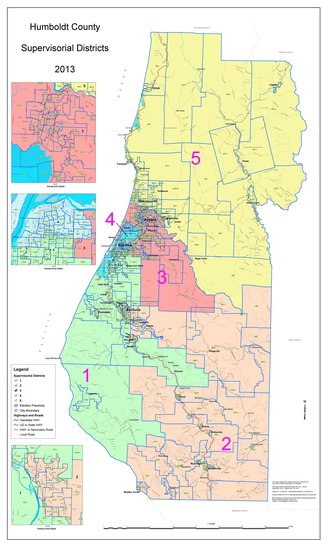
The current map of Humboldt County’s five supervisor districts. | Image via County of Humboldt
The county supervisor districts will soon change shape — probably not by much, but the new lines could have meaningful consequences. Some might remember, for example, what happened a decade ago. Rex Bohn was getting ready to run for his current First District seat on the Board of Supervisors only to see his then-home in Eureka’s Pine Hill neighborhood [CORRECTION: It was at the end of Henderson on V]. drawn out of the First and into the Fourth District. (He moved; problem solved.)
On Tuesday, the Humboldt County Board of Supervisors was presented with a few different options for how to go about redrawing those lines.
Counties, cities and states have to perform this redistricting, as it’s called, every 10 years following the federal census count, and this time around, jurisdictions in California have some new rules to follow thanks to a pair of bills passed two years ago in the state legislature — AssemblyBill 849 (aka the FAIR MAPS Act) and AB 1276.
At yesterday’s meeting, Chris Chaffee, COO of the independent consulting firm Redistricting Partners, told the board that they had several options:
- They could lead the redistrict process themselves, holding a series of public hearings and eventually selecting their own new map, or
- They could enact a redistricting commission, which could be either:
- entirely independent (redrawing and implementing a new map without board input),
- advisory (developing and presenting the board with a recommended map for approval), or
- a hybrid commission, somewhere between independent and advisory, where the board agrees to accept one of the commission’s proposed maps but the commission reserves the right to reject amendment requests by the board.
Chafee explained that the state has set a firm December 15 deadline for final passage of the new maps, which puts the county in a bit of a time crunch. The entirely independent commission would be the most time consuming, he said, so most counties are choosing a process led by supervisors — and Humboldt County in particular is getting a late start.
Fifth District Supervisor Steve Madrone was annoyed by that fact.
“My preference would be [to establish] a completely independent commission,” he said. “I think that’s what the public’s would probably prefer … .” He said he would like to have seen these options presented a year ago. “That bothers me a bit in that my choices are being limited.”
A few key principles for drawing the boundaries: Each district should take into account “communities of interest,” which means grouping together areas where residents share social and economic interests, use the same transportation facilities and generally think of themselves as a community. They should also be contiguous (meaning no little jurisdictional islands off by themselves), compact (no weird, squiggly peninsulas) and more or less equal in population.
Chaffee said that appointing and training a redistricting advisory committee — say, with one member appointed by each member of the board — is “a great path to go down. The county is working with the California Center for Rural Policy (CCRP) to develop resources and engage in community outreach efforts.
After some discussion among the board members, Second District Supervisor Michelle Bushnell made a motion to do what Chaffee suggested: form a five-member advisory committee with appointees selected by the board.
The motion was approved unanimously. (Third District Supervisor Mike Wilson was absent during the morning session of the meeting. He was remotely attending a meeting of the Bureau of Ocean Energy Management, which was discussing the future of offshore wind energy projects.)
Staff will return next week with an agenda item allowing the board to make appointments to the committee. The schedule calls for the committee to undergo training in September and for a series of community outreach meetings to be held across the county in October. There will be five public hearings before the board adopts a final map in December.
CLICK TO MANAGE